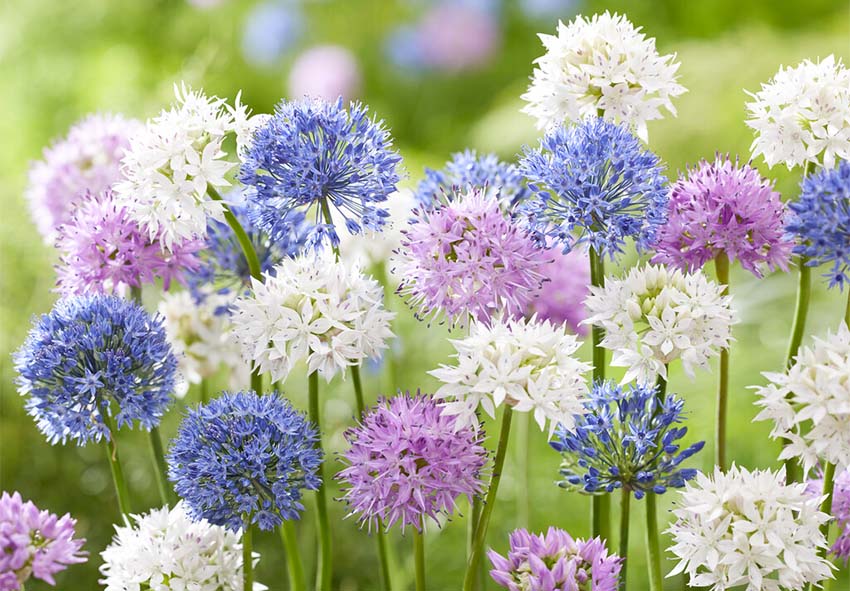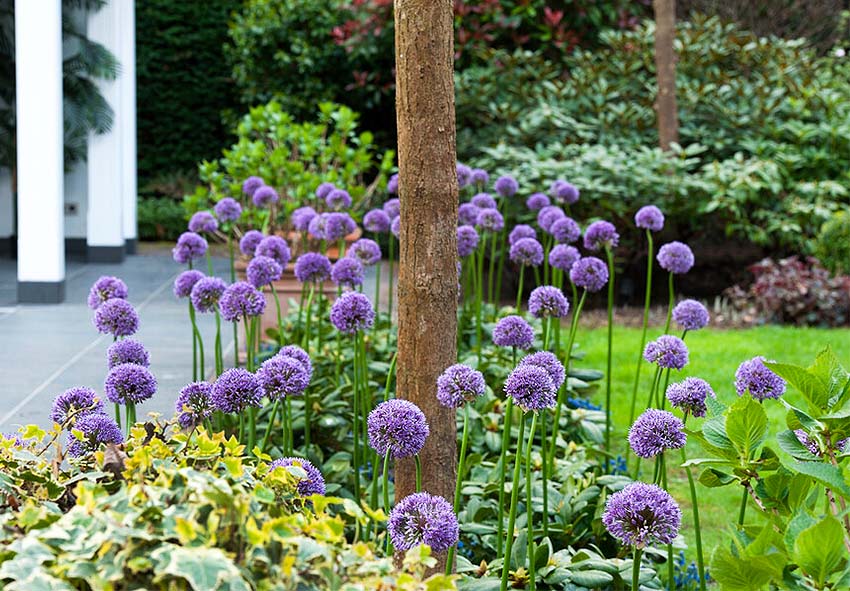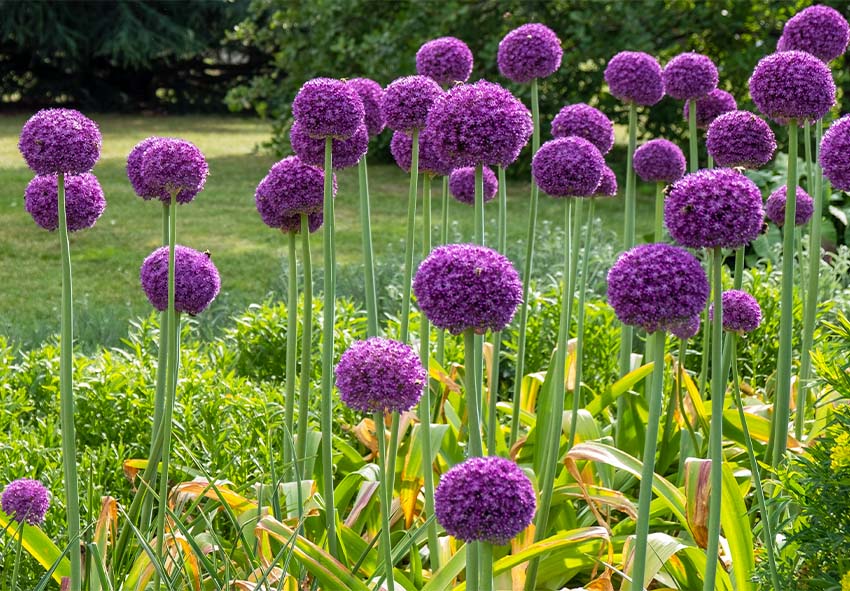Ornamental alliums are a captivating choice for gardens, celebrated for their striking, globe-shaped blooms that bring both height and texture to outdoor spaces. Known for their unique, architectural appeal, alliums fit seamlessly into various garden styles, from contemporary to cottage designs. This guide provides insight into incorporating alliums into your garden, covering everything from design ideas and popular varieties to planting and seasonal care tips. Our gardening blog is a perfect place to find all the information you need!
Why Choose Ornamental Alliums for Your Garden?
Ornamental alliums are a distinctive choice for gardeners looking to add visual interest without the hassle of high-maintenance plants. They stand out for both their aesthetic appeal and resilience, making them an ideal addition to a range of garden environments.
Unique Aesthetic Appeal
Ornamental alliums are instantly recognizable for their round, ball-shaped blooms that add an architectural element to gardens. They come in a variety of colors — purples, whites, and even shades of pink — and bloom sizes, from large spheres to slender drumsticks. Their tall, slender stems and eye-catching colors make them excellent for drawing attention and adding structure to borders, beds, and pathways.
Low-Maintenance Nature
One of the greatest appeals of alliums is their ease of care. Here is a list of key benefits and care tips for ornamental alliums, highlighting their appeal as low-maintenance garden plants:
- Drought Tolerance: Once established, alliums are highly drought-tolerant, requiring minimal watering except during extended dry periods. This makes them ideal for low-maintenance gardens.
- Pest Resistance: Thanks to their naturally protective compounds, alliums are rarely troubled by common garden pests, which makes them easier to care for compared to many other flowering plants.
- Disease Resistance: Alliums are generally resistant to most common garden diseases, contributing to their reliability and ease of maintenance.
- Adaptability to Various Soils: Alliums perform well in a range of soil types as long as they have well-draining soil. They can thrive in sandy, loamy, or even clay soil if drainage is adequate.
- Minimal Watering Requirements: These plants only require occasional watering during very dry spells, making them ideal for gardeners who prefer a low-maintenance routine.
- Simple Care Requirements: With little more than well-draining soil and occasional watering, alliums continue to thrive year after year, making them an excellent choice for both novice and experienced gardeners.
This combination of hardiness, pest and disease resistance, and drought tolerance makes alliums an excellent addition to any garden looking for long-lasting, low-maintenance beauty.
Designing with Ornamental Alliums
Alliums provide height, structure, and season-long interest, making them versatile elements in landscape design. They pair well with a range of plants and can be used to create stunning, multi-season displays.
Adding Height and Structure
Tall allium varieties, such as Allium ‘Gladiator’ and ‘Globemaster,’ are excellent for adding vertical interest to garden borders. These towering plants can be positioned towards the back of beds to create a natural “backdrop” that highlights shorter, more compact plants in front. For the best effect, plant tall alliums in groups or clusters to create a striking focal point that draws the eye upward, giving the garden a sense of height and structure.
Complementary Plant Pairings
Ornamental alliums pair beautifully with various perennials that offer contrasting textures and shapes. For a soft contrast, plant them alongside peonies or salvias, which complement alliums’ spherical flowers with lush, rounded blooms. To create dynamic, layered designs, consider pairing alliums with ornamental grasses or low-growing plants like lamb’s ear, which offer textural variety while helping fill in gaps around the base of the allium stems.
Seasonal Color Schemes
Alliums bring a burst of color to spring and early summer gardens, with some varieties blooming into late summer. Design a seasonal color palette by combining early-blooming alliums with tulips or daffodils for spring color, then extend the display by pairing later-blooming varieties with perennials that carry the color scheme into mid-summer. This approach ensures that your garden remains vibrant and visually engaging over an extended period.
Best Varieties of Ornamental Alliums for Garden Design

Choosing the right allium variety is key to achieving the desired look and impact in your garden. Here are a few popular options, each with unique characteristics to suit different design needs:
- Allium ‘Globemaster’
Known for its extra-large, purple flower heads, Allium ‘Globemaster’ stands out as a striking focal point. These blooms can last for weeks, gradually fading from deep purple to soft lavender. ‘Globemaster’ is ideal for large borders or as a standalone feature due to its impressive size and long bloom time.
- Allium ‘Purple Sensation’
With its mid-sized, vibrant purple blooms, Allium ‘Purple Sensation’ is a popular choice for adding bold color to garden beds. This variety fits well into both traditional and modern garden designs, offering a more moderate height that works well in mixed borders. ‘Purple Sensation’ blooms in late spring, making it a lovely bridge between spring bulbs and early summer perennials.
- Allium schubertii
Allium schubertii, with its starburst-shaped flower heads, adds an artistic and whimsical touch to the garden. The large, airy blooms resemble a fireworks display, bringing a unique texture to beds and borders. Schubertii is perfect as a conversation piece and works well among lower-growing plants, allowing its dramatic flowers to take center stage.
- Drumstick Allium (Allium sphaerocephalon)
The Drumstick Allium is characterized by smaller, egg-shaped blooms in shades of purple and green, providing subtle yet charming color in late summer. This variety is perfect for naturalizing, fitting well into wildflower meadows or mixed plantings where it adds a touch of color without overwhelming the landscape. Its compact size and soft coloring make it an excellent choice for gardeners seeking understated elegance.
Ornamental Alliums for Container Gardens
Ornamental alliums aren’t just for garden beds and borders; they also adapt beautifully to container gardens. Growing alliums in pots offers a convenient way to incorporate their unique beauty into smaller spaces, patios, or balconies. Here’s how to make the most of these striking plants in containers.
Choosing the Right Varieties for Containers
Certain allium varieties are more suited to container gardening, particularly compact types like Allium ‘Millenium’ and the smaller ‘Drumstick’ allium (Allium sphaerocephalon). These varieties stay manageable in size while still providing the distinctive globe-shaped blooms and rich colors alliums are known for. When planting in containers, choose pots that are at least 10–12 inches deep to give the bulbs ample room to establish roots. Ensure the containers have good drainage, as alliums require well-draining soil to prevent rot.
Tips for Container Care
Caring for alliums in containers requires a bit more maintenance than in-ground plantings. By following these tips, you’ll help your container-grown alliums thrive with beautiful blooms each season:
- Frequent Watering: Water container-grown alliums regularly, especially during warm weather, as containers dry out faster than in-ground plantings. Keep the soil moderately moist but avoid waterlogging.
- Soil Refreshing: Each spring, add a layer of compost or a balanced, slow-release fertilizer to refresh the soil and replenish nutrients, promoting strong growth and vibrant blooms.
- Winter Protection in Cold Climates: In colder regions, move containers indoors or place them in a sheltered area during winter to protect the bulbs from freezing temperatures, ensuring they remain viable for the next season.
- Adequate Drainage: Ensure containers have good drainage holes to prevent water buildup, which can lead to root rot. Use a well-draining soil mix suited for bulbs.
- Monitoring Sunlight and Placement: Position containers in full sun for best growth and flowering, but consider partial shade during peak summer heat to prevent soil from drying too quickly.
If you are looking for more detailed allium care tips, we have them in our complete guide for Alliums.
Benefits of Ornamental Alliums Beyond the Garden

Ornamental alliums offer more than just visual appeal in the garden. These versatile plants also support local ecosystems and add elegance to indoor arrangements.
Attracting Pollinators
Allium flowers are excellent for attracting beneficial pollinators, particularly bees and butterflies. Their nectar-rich blooms provide a valuable food source for pollinators in late spring and early summer, supporting local biodiversity. Encouraging pollinators in your garden also has broader benefits, promoting a balanced ecosystem and helping to sustain other flowering plants. Including alliums in your landscape is an eco-friendly choice that contributes to a healthy, vibrant garden environment.
Versatile Use in Floral Arrangements
Alliums have long stems and distinctive blooms, making them a striking choice for floral arrangements. Fresh allium flowers bring architectural elegance to vases, while dried allium seed heads add an artistic touch to dried arrangements. To use alliums in floral decor, harvest them when the blooms are fully open for fresh arrangements, or allow them to dry on the plant before cutting for a long-lasting, sculptural effect. Their unique shapes and enduring quality make them a favorite for both fresh and dried floral designs.
Conclusion
Ornamental alliums are a dynamic addition to any garden, providing height, color, and ease of care. With varieties suited for both in-ground and container gardens, alliums offer versatile options for gardeners of all spaces. From attracting pollinators to adding beauty to floral arrangements, these hardy plants enhance any garden with their distinctive charm. Explore the variety of allium bulbs available for fall planting to bring a touch of elegance and resilience to your garden design.
Frequently Asked Questions (FAQs) about Alliums in Garden Design
1. What makes ornamental alliums unique in garden design?
Ornamental alliums stand out with their spherical blooms, adding height, texture, and structure to gardens. Available in a range of sizes and colors, they bring visual interest across multiple seasons. They also pair well with various plants, creating dynamic, layered garden designs that are both striking and low-maintenance.
2. How do I choose the best allium varieties for container gardening?
Compact varieties like Allium ‘Millenium’ and ‘Drumstick’ are ideal for containers. Look for plants that grow up to about 30–45 cm to ensure they thrive in pots. Select deep containers with good drainage to accommodate the roots and keep the soil well-aerated for healthy growth.
3. What plants complement alliums in garden beds?
Alliums pair well with peonies, irises, and salvias, adding depth and contrast with their tall, rounded blooms. Low-growing plants and ornamental grasses also make excellent companions, balancing the bold structure of alliums with softer textures and creating a harmonious, layered effect in your garden.
4. Can I order Allium bulbs from your online store?
Yes, you can! Our online store Dutch-bulbs.com offers a wide selection of Allium plants, including different varieties and colors. We take pride in providing top-quality plants that are carefully cultivated and shipped with care to ensure they reach you in perfect condition. Visit our online store to explore our collection and place your order for a delightful addition to your home or garden.
5. How can I care for alliums to ensure long-lasting blooms?
Alliums require minimal care but benefit from consistent watering, particularly in dry periods. Add compost or a slow-release fertilizer each spring to maintain soil nutrients. For container-grown alliums, refresh the soil annually and protect the containers in colder months by moving them indoors or covering them to prevent freezing.
Published: 01.11.2024

